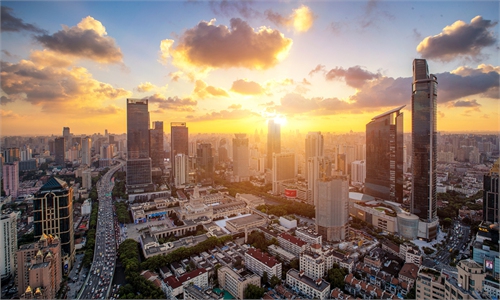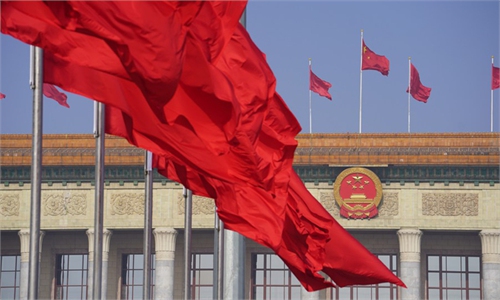
Illustration: Chen Xia/GT
The ongoing two sessions in Beijing is attracting the eyes of the world as China, the most important contributor to global economic growth, is charting a development course for the next five years, most significantly, encouraging further technology innovation and sprucing up self-reliance in critical technologies, so that the country is able to continue on its path to becoming an advanced economy.
The two sessions will fix the "loopholes and deficiencies" that have bedeviled Hong Kong's electoral system, which if not timely rectified, may sink the major financial center and tourism hub in Asia to political logjam, street fights, and endless chaos.
As some forces outside the borders always hope to derail China's growth by ratcheting up technology controls, the decision-makers in Beijing, nevertheless, want to shore up domestic spending and investment in research and innovation, and keep the country running along a fast yet solid track.
According to the five-year plan, China's investment in research and development will rise by an annual growth rate of at least 7 percent. Cutting-edge semiconductor microchips, artificial intelligence, robotics, biomedicine, ultrafast internet and other ground-breaking technologies are listed as major exploration fields. New and high technologies ought to be firmly grasped by China's own hands so that the country won't be blackmailed.
Unlike other economies, China is trending back to monetary policy normalcy, by cutting its national budget deficit to 3.2 percent of GDP in 2021, from last year's 3.6 percent. It will also trim local government bonds to 3.65 trillion yuan from last year's 3.75 trillion.
The move to deleverage the macro economy and reduce risks to the financial system is in sharp contrast with other countries, which are still pushing for huge fiscal stimulus plans, and, their central banks are keeping their interest rates at around zero, while buying government-issued debts to increase cash supplies and buoy up their economies - building up the risk of bubbling asset prices and hyperinflation there.
To counter a few Western powers' endless military muscle projections at China's near seas, the National People's Congress (NPC), the parliament, is expected to approve the government's plan to raise national defense expenditure by 6.8 percent to 1.36 trillion ($209 billion) for 2021, surpassing last year's rise of 6.6 percent. It's a warranted budget rise and needs to be consistently and considerably raised in subsequent years, considering the drastic alterations in the country's external security situation.
China announced that its giant economy is anticipated to expand by over 6 percent this year, a modest growth target that China will comfortably exceed. Most economists believe the real economy will easily grow by 7 percent, because of the lower base in 2020. International organizations like the IMF and World Bank have estimated China's GDP will rise by approximately 8 percent, which sounds more plausible.
There is declining interest among Chinese people to gauge how long it will take the nation to surpass the US in GDP, so long as their wages continue to rise and there are plenty of jobs available. China is already the world's largest trader and its foreign trade volume will keep growing, which is proved by 32.2 percent surge in the first two months of 2021. If calculated by purchase power parity, China is already the largest economic power.
To prevent more disruptions to the growth from sporadic COVID-19 outbreaks, China is launching a massive drive to inoculate its population with self-developed highly effective vaccines, and the so-called herd immunity is expected to come into effect at this year's end. Thanks to Beijing's strong tenacity in responding to the infectious disease, the Chinese economy rose by an impressive 2.3 percent last year, compared to sizable contractions in other major economies.
Ever since the historical win over containing the pandemic, Chinese leadership has evidently gained much confidence in resolving other challenges - including countryside vitalization, high-quality and green development, pushing forward the Belt and Road Initiative, and leading the world to fight unilateralism and protectionism, and safeguarding the global free trade system.
Rural modernization is closely correlated with the country's push to cut carbon dioxide emissions and achieve net-zero emissions by 2060. The central government report said in the vast swatch of China's northern regions, 70 percent of winter heating will come from clean energy in five years. The concept of "Lucid waters and lush mountains are invaluable assets" is widely lauded and accepted by the people.
The government will continue to encourage the development of solar panels, wind turbines, hydropower and nuclear power generation. In Chinese cities, gasoline-powered taxis and bus fleets will be largely replaced by electric vehicles, as has taken place in Beijing, Shanghai and Shenzhen. Meanwhile, the hordes of delivery couriers running on the streets will be asked to use electric motorcycles.
China hopes to continue to cooperate with other economies in curbing climate change and fostering new economic growth points, such as exporting its high-speed trains, 5G wireless networks, and paperless mobile payment systems.
But, if some major powers in the world refuse to stop using national security as a ruse and gamble against China, the dreams of industrialization and modernization in many emerging and developing countries that cooperate with China and have greatly benefited from China's peaceful rise, will be impacted. So, the world should be united and say a big no to a few imperialist bullies.
The author is an editor with the Global Times. bizopinion@globaltimes.com.cn


